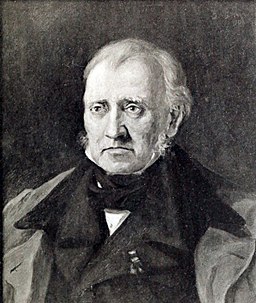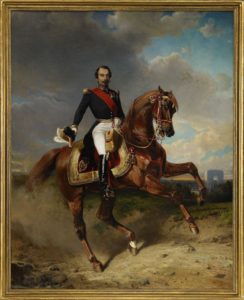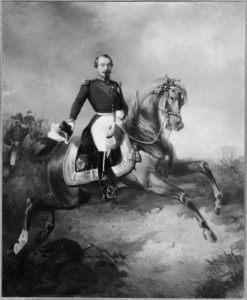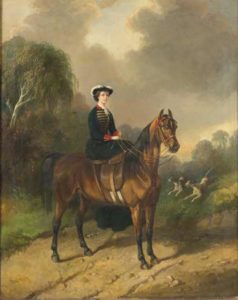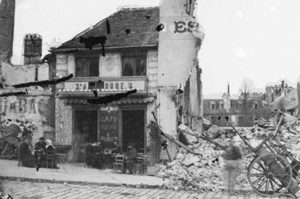In this blog I shall tell the tale of two fates briefly intertwined in Paris during the Second Empire: On one side a boy from Saint-Leu who became emperor and on the other a Danish boy from the Unity of Brethren who became painter. I shall also tell you about the mysterious disappearance of a painting from the Louvre and the early days of spiritism in Paris… For once, this blog will say almost nothing of Repatchit. It is a story about strange coincidences – indeed, you may say that it is a historical « fun facts » news item. Please read on if this appeals to you – otherwise, see you soon for a more typical blog!center; »>– Tanja Kiørboe Vanpeene
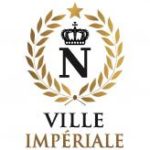
Kiørboe arrives in Saint-Leu-la-Forêt
My name is Tanja Kiørboe Vanpeene. In 2012, when I moved back to France after a few years in the US, I settled in Saint-Leu-la-Forêt.
The same year, this town became « Ville Impériale« , but I did not pay much attention to that: I was busy starting my business! In 2013, Repatchit was launched, with the ambition of introducing the American tradition of « memory quilts » in France.
Some years went by, business was steady, my children grew up and my family took root. I got to know the locals and realized that « my » town was teeming with creativity – musicians, artists, crafters and makers, writers…
The meeting of crafts and arts
In 2015, I met another « saint-loupienne » during a class at the Chambre de Métiers: Christine Orihuela who paints and organizes sessions of arts & well-being. We rapidly decided to collaborate. By 2016, we worked on several projects to promote arts and crafts in Saint-Leu-la-Forêt.
In order to carry out these projects, we started working with the Tourist Office of Saint-Leu-la-Forêt. Through the meetings with these passionate people I discovered the fascinating architectural and historical heritage of Saint-Leu-la-Forêt.

Napoléon III, a captivating "saint-loupien"
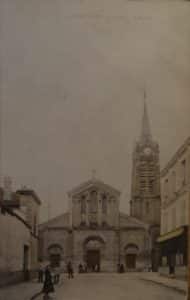
To this day, several buildings in Saint-Leu-la-Forêt tell the tale of the imperial presence on the territory. The church Saint-Gilles is a spectacular example of this, as it was completely restored in 1851 by Charles-Louis-Napoléon Bonaparte (the futur Napoléon III). He spent a good part of his childhood from 1808 to 1815, with his mother, Queen Consort Hortense, at Saint Leu Castle.
The fate of Charles-Louis-Napoléon Bonaparte is truly captivating. He went from exile to becoming the first French president elected by universal suffrage, and then on to Emperor… But well before all of that, during his early childhood, Charles-Louis was also a saint-loupien! But this blog has no ambition of re-telling his whole life. Let us rather contemplate a tiny detail, a meeting utterly unworthy of being mentioned in the history books…
The Painter and the Emperor
In 1855, Napoléon III meets a painter who has become renowned for his animal paintings. From him, Napoléon III orders an equestrian portrait for his Louvre apartments. The name of the painter is Carl Friederich Kiørboe.
Does that name ring a bell? I’m sure it does! Let’s get ready for a quick climb up into the family tree!
To make it (extremely) short, the father of the painter, Andreas Friedrich Kiørboe, had a brother, Peter Kiørboe (1778 – 1835) who got a son, Peter August Kiørboe (1810 – 1895), who got a son, Frederick Rudolf Leopold Kiørboe (1841 – 1917) who got a son, Aage Meining Kiørboe (1879 – 1916), who got a son, Flemming Kiørboe (1910 – 1984) who got a son, Flemming Kiørboe (1943 – ) who got a daughter, Tanja Kiørboe (1971 – ) who ended up settling down in Saint-Leu-la-Forêt. Yeap, that’s me, hello there!
Thusly, this painter is actually the nephew of my great-great-great-great-grand father. I completely agree that it is not what you would call closely related – but to me it was a fascinating discovery. When I settled in this town I did not know that Saint-Leu-la-Forêt was particularly linked to Napoléon III. Neither did I know anything about this painter. Once I found out, I could not resist the urge to dig deeper to learn more about my ancestor – and my research ended up becoming this blog article…
The spelling of a name...
My quest became a tad complicated because the name can be written in so many different ways.
To begin with, he has two first names which varies: Karl, Carl or Charles? Fredrik, Frederik, Friedrich, Friederich or Frédéric? But the family name is even worse: Kiørboe ? Kiörboe ? Kiörboë ? Kiorboe ? Kiorbe? Kioerbe ? Kiorbé ? Kierboï ! Kioerboe ? Corbeau ? !
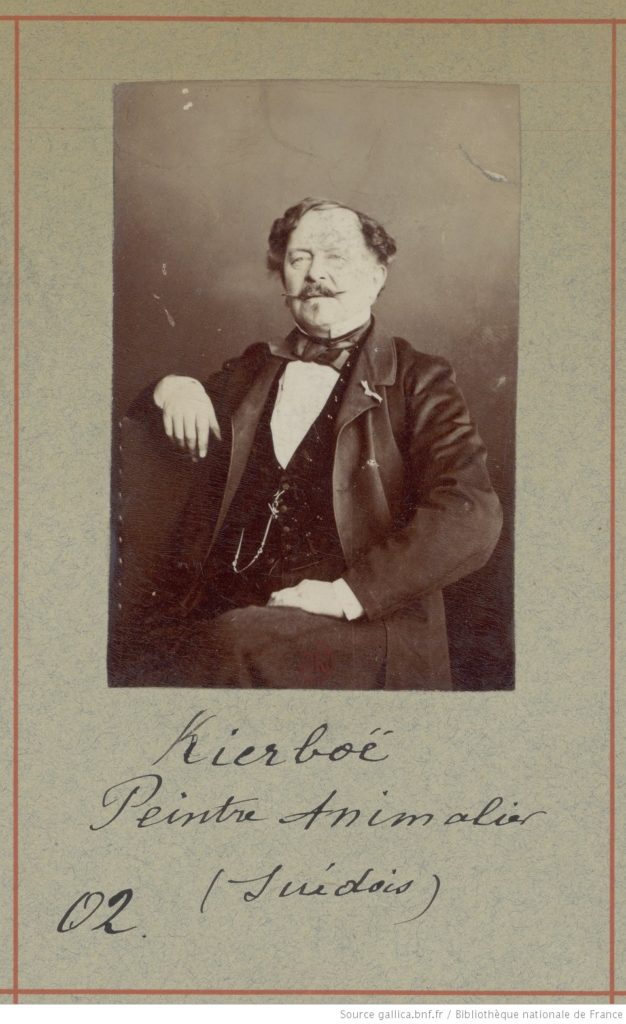
A questionable nationality...
His nationality is questionable too. He is described as being Swedish by most of my sources, even though he was born in Christiansfeld in Schleswig (Denmark). His father was Norwegian and his mother Swedish. According to some sources he was Danish. Others say Norwegian or even Swiss. All that I can say for sure is that he lived in Denmark, Germany and Sweden before settling in France. And it seems clear that he saw himself as Swedish.
The peculiar career of a Second Empire painter
The story about the life of Carl Friederich Kiørboe (1799-1876) is a tale of a fascinating fate at a turning point in history.
Nothing seemed to destine him to become a painter. Born in Christiansfeld, in a congregation of the Unity of Brethren (a not-so-well-known branch of the Protestant church), little Carl Friederich enters the school of the congregation when he is 10 years old, in 1809. But school doesn’t work out so well for him…
In 1813, young Carl Friederich must be sent away to a different community of the Unity of Brethren, in Zeitz. In the archives, the Conference of Elders notes that the boy’s departure must happen quickly: « for at the present time there could be critical circumstances for the congregation »… What on earth had happened? Unfortunately, we have no way of knowing.
Carl Friederich travels to Zeitz in Germany. But that doesn’t seem to work out so well either. He cannot stay. In 1817, his apprenticeship within the congregation of the Unity of Brethren is brought to an end as the young man (now 18 years old) is sent to Altona (Hamburg) where he is apprenticed to a tradesman named Sommer. The Conference of Elders states its disagreement… but gives way at the insistence of Carl Friederich’s father who promises to take full responsibility for the consequences.
Altona doesn’t seem to have been a huge success either. Barely two years later, in 1819, the father calls back his now twenty-year-old son to have him enter the family business in Christiansfeld.
Then, I think (hope), the parents must have ended up accepting that their son was not made for a commercial career.
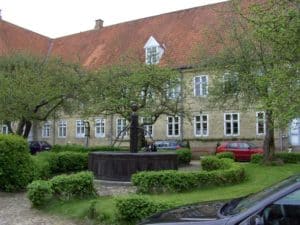
Finding his place...
The end of the struggle to find his place is near… Carl Friederich is sent to Sweden where his uncle (his mother’s brother, Sven Adolf Norling), has become the director of the newly-founded Veterinary School.
In Stockholm, Carl Friederich studies animal anatomy. His uncle, veterinary and hippologist, urges him to enter the veterinary school and encourages his desire to draw. Carl Friederich seems to have finally found someone who listens and understands – or at least, someone whose suggestions suit him!
(At this point I must add a thank-you note to the Swedish veterinary museum which was very helpful in my research: Thanks!)
Carl Friederich undertakes veterinary studies, continues drawing and takes up painting with pastels, then oil painting.
He joins the Kongliga Jämtlands Hästjägarkår (the Royal Corps of mounted hunters) in 1829 thereby engaging in a military career of about ten years.
Simultaneously, he co-edits lithographies with horse portraits (« Portraits des chevaux les plus célèbres ou haras royal suédois à Strömsholm »), and he helps translating and illustrating a book called « Biography of the remarkable cavalry horse Adam ». What a title, makes you want to read it, doesn’t it? I haven’t found the actual book yet.
This literary phase goes on for a few years, from 1829 à 1833. As for his military career, he is promoted lieutenant and Captain in the Cavalry before he leaves the army for good in 1846.
A(nother) painter in Paris
Carl Friederich settles down in Paris.
His painting skills improves under the guidance of the Dutch painter Henning (who also lives in Paris).
As early as 1841, he exhibit his paintings at the « Salon » and some of his paintings win prizes in 1844 and 1846.
In 1846, he marries a French widow by the name of Hortense. Several sources tell strange tales about their relationship…
They move to Parc Montretout, in Saint Cloud.
A(nother) emperor in Paris
By 1840, the future Napoléon III is still in London, busy preparing a coup d’Etat which turns out to be a complete failure, leading him straight to prison. From 1840 to 1846, while Carl Friederich really establishes himself as painter, exhibiting his paintings in London and Paris, Louis-Napoléon Bonaparte spends 6 years in detention at the Fortress of Ham. But let’s not linger on that.
A few years later (after managing to escape, getting exiled and then getting elected), Napoléon becomes the President of the Second Empire in 1848. Then, by 1852, he officially becomes « Napoléon III, Emperor of the French ».
In 1855, the Imperial Commission organizes the « Exposition universelle ». Perhaps that is where they meet? At any rate, Napoléon III asks Carl Friederich to make an equestrian portrait.
The painter makes two sketches so that the emperor can choose how he wants to be depicted. The Emperor choose to be seen galloping and the painter goes to work. According the Louvre archives, this full-sized painting was bought for the sum of 8.000 francs (the equivalent of about 20.000 euros today).
The plot thickens and the portrait vanishes
So, late 1855 (or perhaps early 1856), Carl Friederich has done the job and hands in the equestrian portrait of the Emperor.
But after it arrives at Louvre, they « lose track of it ».
Wait … Lose track of it ? By Jove, this is a full-sized imperial portrait we’re talking about!
Oh well. Paris has been through a lot of dark and stormy times since 1855, so I suppose it is not surprising if this portrait has been lost.
Destroyed, stolen or forgotten, who knows?
Today, however, it is possible to find almost anything on the internet…
I think I have found two interesting leads: An equestrian portrait of Napoléon III, signed Carl Friederich Kiørboe, was sold in 2011 for 125.000 Swedish crowns (about 12.000 euros) at an auction in Sweden (Auktionsverket.com). Reportedly, the size of the portrait is 63 cm x 130 cm.
I haven’t managed to get in touch with the buyer.
Another painting, listed in the archives of the Nationalmuseum in Sweden, also matches the description (but watch out, the horse’s sock is on a different leg…). Found in black-and-white photo only, this painting is just about the same size: 163 x 131 cm (or, apparently, 202 x 170 x 16 cm when you include the frame which isn’t in the photo).
As I write this, the museum has not yet answered my mails.
Is one of these paintings the one that went missing from the Louvre? So far, this question stands unanswered.
The fact that I have found two paintings, different yet so similar, seems to confirm that Carl Friederich sometimes made multiple versions of the same painting.
Carl Friederich also painted Empress Eugénie on horseback, but this painting doesn’t seem to be part of the order for Louvre. This painting is today at Statens Museum for Kunst, in Copenhagen. I haven’t been able to see it, since it is resting in the archives… By the way, the museum got it in 1919 as part of a donation from Emma Hansen, the wife of a Consul General. Yet another lead for some other time?
As for the other paintings by Carl Friederich, they are scattered over museums in Sweden, Denmark, France… and surely in private collections.
End of the road for two paths which crossed
In the end, the two men – the Emperor and the painter, Napoléon III and Carl Friederich Kiørboe, both leaves Paris within a year of each other.
In 1870, Napoléon III goes to war against the Prussian army. From there, the road that awaits the Emperor leads him to crisis, captivity, exile – and death.
As for the painter, Carl Friederich remains in Paris, even after the demise of his wife Hortense in 1863. Nothing seems to indicate that he wants to leave. He still lives in Montretout, in Saint Cloud. Older than the Emperor, he’s going to reach the age of 72 by June 1871! But by then he is no longer in Saint Cloud.
After the defeat of the Imperial army comes the time of the Paris commune during spring 1871.
His home and workshop in Saint Cloud are damaged. He loses his collection of stuffed animals that he used for his paintings. He escapes to Dijon where he moves in with his stepdaughter (Hortense’s daughter) and her husband.
And Dijon is where he draws his last breath five years later, in 1876. He leaves no descendants.
…
Communicating with the spirits on Rue du Chemin de Versailles 74
Before he left this world, Carl Friederich had already had some other-worldy encounters. He is mentioned in the list of eye-witnesses for some spiritism meetings during which a spirit had written a message (« automatic writing »). Carl Friederich attended these meetings, held by baron Guldenstubbé, in the company of Prince Leonide Galitzin of Moscow and the German ambassador of the Court of Wurttemberg.
The baron was one of the firts to introduce table-turning to communicate with the deceased in spiritism in France, and he was a pioneer of automatic writing. He wrote several books (himself, I think…), and he describes one of his witnesses thusly « M. Kiorbé, distinguished artist, in Paris, living at rue du Chemin de Versailles, 43″. A neighbor, then, since Guldenstubbé himself lives in number 74… It seems likely that this rue du Chemin de Versailles was a prolongation of what has become Avenue de Versailles in the 16th arrondisseent of Paris. Another lead…?
THE END ???
…Oh but so many leads remains unexplored!
Is it true that, while living in Stockholm, Carl Friederich became a personal friend of the Royal family, the Bernadottes? Did Hortense really lock up Carl Friederich until he finished his paintings when he hadn’t been working enough? How many versions of Napoleon III on horseback did Carl Friederich actually paint? When and how did the original of the originals go missing (the one that was ordered by, painted for and delivered to Napoléon III)?
It is so hard to stop while there are so many intriguing leads glittering here and there like tiny gems But I must stop, I must leave this computer keyboard for now and get back to my sewing machine!
If you have read the whole article I hope you’ve found it fun and/or interesting. Please feel free to comment on it, let me know if you come across information which might be linked to some part of the story – and let me know what lead you think I should pursue.
Saint-Leu-le-Forêt, Monday March 26th 2018 — Tanja Kiørboe Vanpeene
My sources
This article has been written after consulting a large nummber of different sources. Most of these sourceshave been found through Google internet searches.
However, two exceptions must be pointed out:
Several pages of biography from a book about the genealogy of the Kiørboe family have been made available by Flemming Kiørboe and Nils Kiørboe. These ages have particularly inspired the paragraphs about the childhood and youth of Carl Friederich.
And what is probably the most extensive biography made to this very day was made available in paper version by the Veterinary Museum in Skara, Sweden (Veterinärhistoriska Museet). Their help in procuring me this very complete work of outstanding quality has ben much appreciated.
Karl Fredrik Kiørboe : Veterinär, Militär, Konstnär. Meddelande (Veterinärhistoriska museet), Nr. 41. Edité par Skara : Veterinärhistoriska Museet i Skara, 1999.
Catherine Granger, « La liste civile de Napoléon III : le pouvoir impérial et les arts, Thèse de doctorat en histoire de l’art », Revue d’histoire du XIXe siècle [En ligne], 22 | 2001, mis en ligne le 28 juin 2005, seen 15th of March 2018. URL : http://journals.openedition.org/rh19/288 ; DOI : 10.4000/rh19.288
Artnet.fr List of works by Carl Fredrik Kiorboe sold on auctions
Wikipedia Article about Carl Fredrik Kiörboe
Wikipedia Article about Sven Adolf Norling
Welbachs Kunstnerleksikon Article about Carl Friederich Kiørboe
Nationalmuseum.se ; Photo in black and white Napoléon III on horseback
Statens Museum for Kunst : Photo of the painting « Impératrice Eugénie à cheval », information about the painting by Carl Friederich Kiørboe
Store Norske Leksikon article about Carl Fredrik Kiørboe
Nordisk Familiebog (1911) digital version. Article about Karl Fredrik Kiörboe.
Auction.fr auction house mentionning Karl KIOERBOE
Journal des haras, chasses, et courses de chevaux, des progrès des sciences zooïatriques et de médecine comparée : Volume 4, digitalized version mentioning Kiorbé and the Salon 1846.
Bibliothèque Nationale de France Photo of Kierboï from Nadar. Page BNF about Carl Fredrik Kiörboe / Kiorbe / Kiorbé / Kiorboe. Nadar photo also mentioned by ministère de la Culture.
Teutsche Zietschrift für die gesammte Thierheilkunde par Krieger, 1830. Digitalized book. Mentions the book by C. F. Kioerbe
Le musée des Sorcières, Mages et Alchimistes Grillot de Givry (1929) mentions M. Kiorbé.
The Spirit Book: The Encyclopedia of Clairvoyance, Channeling, and Spirit Communication Raymond Buckland mentions Kiorboe.
The Hope Gallery mini-biography about Carl Frederik Kiørboe.
National Portrait Gallery photo of Carl Frederik Kiorboe, by A. Legras.
Art signature dictionary : confirmed signature Carl Fredrik Kiörboe.
Wikidata : article about Carl Fredrik Kiörbo
My sources
This article has been written after consulting a large nummber of different sources. Most of these sourceshave been found through Google internet searches.
However, two exceptions must be pointed out:
Several pages of biography from a book about the genealogy of the Kiørboe family have been made available by Flemming Kiørboe and Nils Kiørboe. These ages have particularly inspired the paragraphs about the childhood and youth of Carl Friederich.
And what is probably the most extensive biography made to this very day was made available in paper version by the Veterinary Museum in Skara, Sweden (Veterinärhistoriska Museet). Their help in procuring me this very complete work of outstanding quality has ben much appreciated.
Karl Fredrik Kiørboe : Veterinär, Militär, Konstnär. Meddelande (Veterinärhistoriska museet), Nr. 41. Edited by Skara : Veterinärhistoriska Museet i Skara, 1999.
Catherine Granger, « La liste civile de Napoléon III : le pouvoir impérial et les arts, Thèse de doctorat en histoire de l’art », Revue d’histoire du XIXe siècle [En ligne], 22 | 2001, mis en ligne le 28 juin 2005, consulté le 15 mars 2018. URL : http://journals.openedition.org/rh19/288 ; DOI : 10.4000/rh19.288
Artnet.fr List of paintings by Carl Fredrik Kiorboe sold on auctions
Wikipedia Article about Carl Fredrik Kiörboe (available on Wikipedia in Swedish and German)
Wikipedia Article about Sven Adolf Norling
Welbachs Kunstnerleksikon Article about Carl Friederich Kiørboe
Nationalmuseum.se ; Photo in black-and-white of painting of Napoléon III on horseback
Statens Museum for Kunst : Color photo of the painting Empress Eugénie on horseback by Carl Friederich Kiørboe.
Store Norske Leksikon article about Carl Fredrik Kiørboe.
Nordisk Familiebog (1911) digitalized version. Article about Karl Fredrik Kiörboe.
Auction.fr auction house mentioning Karl KIOERBOE
Journal des haras, chasses, et courses de chevaux, des progrès des sciences zooïatriques et de médecine comparée : Volume 4, digitalized version mentioning Kiorbé and the « Salon » 1846.
Bibliothèque Nationale de France Photography of Kierboï from Nadar. See also Page BNF about Carl Fredrik Kiörboe / Kiorbe / Kiorbé / Kiorboe. The photography from Nadar is also referenced by the ministère de la Culture.
Teutsche Zietschrift für die gesammte Thierheilkunde by Krieger, 1830. Digitalized book in German, mentioning the book with litography by C. F. Kioerbe
Le musée des Sorcières, Mages et Alchimistes Grillot de Givry (1929) mentions M. Kiorbé.
The Spirit Book: The Encyclopedia of Clairvoyance, Channeling, and Spirit Communication Raymond Buckland mentions Kiorboe.
The Hope Gallery tiny biography of Carl Frederik Kiørboe.
National Portrait Gallery photography of Carl Frederik Kiorboe, by A. Legras.
Art signature dictionary: Confirmed signature of Carl Fredrik Kiörboe.
Wikidata: Data on Carl Fredrik Kiörboe.

